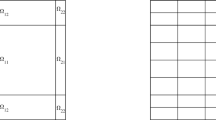Abstract
We present a technique for numerically solving convection-diffusion problems in domains \(\varOmega \) with curved boundary. The technique consists in approximating the domain \(\varOmega \) by polyhedral subdomains \(\mathsf{{D}}_h\) where a finite element method is used to solve for the approximate solution. The approximation is then suitably extended to the remaining part of the domain \(\varOmega \). This approach allows for the use of only polyhedral elements; there is no need of fitting the boundary in order to obtain an accurate approximation of the solution. To achieve this, the boundary condition on the border of \(\varOmega \) is transferred to the border of \(\mathsf{D }_h\) by using simple line integrals. We apply this technique to the hybridizable discontinuous Galerkin method and provide extensive numerical experiments showing that, whenever the distance of \(\mathsf{{D}}_h\) to \(\partial \varOmega \) is of order of the meshsize \(h\), the convergence properties of the resulting method are the same as those for the case in which \(\varOmega =\mathsf{{D}}_h\). We also show numerical evidence indicating that the ratio of the \(L^2(\varOmega )\) norm of the error in the scalar variable computed with \(d>0\) to that of that computed with \(d=0\) remains constant (and fairly close to one), whenever the distance \(d\) is proportional to \(\min \{h,Pe^{-1}\}/(k+1)^2\), where \(Pe\) is the so-called Péclet number.










Similar content being viewed by others
References
Babuska, I.: The finite element method with penalty. Math. Comp. 27, 221–228 (1973)
Barrett, J.W., Elliott, C.M.: Finite element approximation of the Dirichlet problem using the boundary penalty method. Numer. Math. 49, 343–366 (1986)
Bramble, J.H., King, J.T.: A robust finite element method for nonhomogeneous Dirichlet problems in domains with curved boundaries. Math. Comp. 63, 1–17 (1994)
Bazant, M.: Conformal mapping of some non-harmonic functions in transport theory. Proc. R. Soc. Lond. A 460, 1433–1452 (2004)
Cockburn, B., Dong, B., Guzmán, J., Restelli, M., Sacco, R.: Superconvergent and optimally convergent LDG-hybridizable discontinuous Galerkin methods for convection-diffusion-reaction problems. SIAM J. Sci. Comput. 31, 3827–3846 (2009)
Cockburn, B., Gopalakrishnan, J., Lazarov, R.: Unified hybridization of discontinuous Galerkin, mixed and continuous Galerkin methods for second order elliptic problems. SIAM J. Numer. Anal. 47, 1319–1365 (2009)
Cockburn, B., Gopalakrishnan, J., Sayas, F.-J.: A projection-based error analysis of HDG methods. Math. Comp. 79, 1351–1367 (2010)
Cockburn, B., Gupta, D., Reitich, F.: Boundary-conforming discontinuous Galerkin methods via extensions from subdomains. SIAM J. Sci. Comput. 42, 144–184 (2010)
Cockburn, B., Guzmán, J., Wang, H.: Superconvergent discontinuous Galerkin methods for second-order elliptic problems. Math. Comp 78, 1–24 (2009)
Cockburn, B., Sayas, F.-J., Solano, M.: Coupling at a distance HDG and BEM. SIAM J. Sci. Comput. 34, A28–A47 (2012)
Cockburn, B., Solano, M.: Solving Dirichlet boundary-value problems on curved domains by extensions from subdomains. SIAM J. Sci. Comput. 34, A497–A519 (2012)
Cockburn, B., Qiu, W., Solano, M.: A priori error analysis for HDG methods using extensions from subdomains to achieve boundary-conformity. Math. Comp. doi:10.1090/S0025-5718-2013-02747-0
Lew, A., Buscaglia, G.: A discontinuous-Galerkin-based immersed boundary method. Int. J. Numer. Methods Eng. 76, 427–454 (2008)
Nguyen, N.C., Peraire, J., Cockburn, B.: An implicit high-order hybridizable discontinuous Galerkin method for linear convection-diffusion equations. J. Comput. Phys. 228, 3232–3254 (2009)
Peskin, C.: Flow patterns around heart valves: a numerical method. J. Comput. Phys. 10, 252–271 (1972)
Rangarajan, R., Lew, A., Buscaglia, G.: A discontinuous-Galerkin-based immersed boundary method with non-homogeneous boundary conditions ans its application to elasticity. Comput. Methods Appl. Mech. Eng. 198, 1513–1534 (2009)
Acknowledgments
The authors would like to thank the anonymous referees for their comments and feedback which resulted in a better version of this paper.
Author information
Authors and Affiliations
Corresponding author
Additional information
Partially supported by the National Science Foundation (Grant DMS-1115331) and by the Minnesota Supercomputing Institute, University of Minnesota.
Rights and permissions
About this article
Cite this article
Cockburn, B., Solano, M. Solving Convection-Diffusion Problems on Curved Domains by Extensions from Subdomains. J Sci Comput 59, 512–543 (2014). https://doi.org/10.1007/s10915-013-9776-y
Received:
Revised:
Accepted:
Published:
Issue Date:
DOI: https://doi.org/10.1007/s10915-013-9776-y




